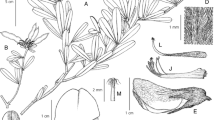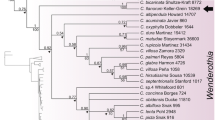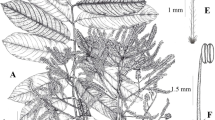Summary
Three new species of the genus Millettia; M. calcicola Mattapha, G.P.Lewis & Hawkins, M. fulva Mattapha, F.Forest & Hawkins and M. khaoyaiensis Mattapha, Schrire & Suddee, are described and illustrated. Key diagnostic characters of these species are discussed.







Similar content being viewed by others
References
Adema, F. (2000). Notes on Malesian Fabaceae (Leguminosae-Papilionoideae): 7, the genus Millettia. Blumea 45: 403 – 425.
Bachman, S., Moat, J., Hill, A. W., de la Torre, J. & Scott, B. (2011). Supporting Red List threat assessments with GeoCAT: Geospatial Conservation Assessment Tool. ZooKeys 150: 117 – 126. https://doi.org/10.3897/zookeys.150.2109
Craib, W. G. (1912). Contributions to the flora of Siam: Dicotyledones. University of Aberdeen, Aberdeen.
____ (1928). Florae Siamensis Enumeratio 1 (3). The Siam Society, Bangkok.
Doyle, J. J., Doyle, J. L, Ballenger, J. A., Dickson, E. E., Kajita, T. & Ohashi, H. (1997). A phylogeny of the chloroplast gene rbcL in the Leguminosae: Taxonomic correlations and insights into the evolution of nodulation. Amer. J. Bot. 84: 541 – 554. https://doi.org/10.2307/2446030
____, Chappill, J., Bailey, C. & Kajita, T. (2000). Towards a comprehensive phylogeny of legumes: evidence from rbcL sequences and non-molecular data. In: P. Herendeen & A. Bruneau (eds), Advances in Legume Systematics part 9, pp. 1 – 20. Royal Botanic Gardens, Kew.
Dunn, S. (1912). A revision of the genus Millettia Wight et Arn. J. Linn. Soc., Bot. 41: 123 – 243. https://www.biodiversitylibrary.org/item/8406#page/142/mode/1up [Accessed 25 March 2022].
Gagnepain, F. (1916). Légumineuses: Papilionées. In: M. H. Lecomte (ed.), Flore Générale de l’Indo-Chine 4: 361 – 396. Masson et cie, Editeurs, Paris.
Geesink, R. (1984). Scala Millettiearum: A Survey of the Genera of the Millettieae (Legum.-Pap.) with Methodological Considerations. Leiden Bot. Ser. 8. E. J. Brill & Leiden University Press, Leiden.
Hu, J.-M. (2000). Phylogenetic relationships of the tribe Millettieae and allies — the current status. In: P. Herendeen & A. Bruneau (eds), Advances in Legume Systematics part 9: 299 – 310. Royal Botanic Gardens, Kew.
_____, Lavin, M., Wojciechowski, M. F. & Sanderson, M. J. (2000). Phylogenetic systematics of the tribe Millettieae (Leguminosae) based on chloroplast trnK/matK sequences and its implications for evolutionary patterns in Papilionoideae. Amer. J. Bot. 87 (3): 418 – 430. https://doi.org/10.2307/2656638.
_____, _____, _____ & _____ (2002). Phylogenetic analysis of nuclear ribosomal ITS/5.8S sequences in the tribe Millettieae (Fabaceae): Poecilanthe-Cyclolobium, the core Millettieae, and the Callerya group. Syst. Bot. 27 (4): 722 – 733. https://bioone.org/journals/systematic-botany/volume-27/issue-4.
_____ & Chang, S. (2003). Two new members of the Callerya group (Fabaceae) based on phylogenetic analysis of rbcL sequences: Endosamara racemosa (Roxb.) Geesink and Callerya vasta (Kostern.) Schot. Taiwania 48 (2): 118 – 128. https://doi.org/10.6165/tai.2003.48(2).118
IUCN Standards and Petitions Committee (2022). Guidelines for Using the IUCN Red List Categories and Criteria. Version 15.1. Prepared by the Standards and Petitions Committee. Downloadable from https://www.iucnredlist.org/documents/RedListGuidelines.pdf [Accessed 1 May 2022].
Kajita, T., Ohashi, H., Tateishi, Y., Bailey, D. & Doyle, J. (2001). rbcL and legume phylogeny, with particular reference to Phaseoleae, Millettieae and allies. Syst. Bot. 26 (3): 515 – 536. https://bioone.org/journals/systematic-botany/volume-26/issue-3 [Accessed 2 May 2015].
Käss, E. & Wink, M. (1995). Molecular phylogeny of the Papilionoideae (family Leguminosae): rbcL gene sequences versus chemical taxonomy. Bot. Acta 108: 149 – 162. https://doi.org/10.1111/j.1438-8677.1995.tb00845.x
_____ & _____ (1996). Molecular evolution of the Leguminosae: Phylogeny of the three subfamilies based on rbcL-sequences. Biochem. Syst. Ecol. 24: 365 – 378. https://doi.org/10.1016/0305-1978(96)00032-4
Lôc, P. K. & Vidal, J. E. (2001). Legumineuses-Papilionoideae-Millettieae. In: P. Morat (ed.), Flore du Cambodge, du Laos et du Vietnam 30. Museum National D’histoire Naturelle, Paris.
Lock, J. & Heald, J. (1994). Legumes of Indo-China a check-list. Royal Botanic Gardens, Kew.
Mattapha, S. (2017). The systematics of tribe Millettieae (Leguminosae-Papilionoideae). PhD Thesis, School of Biological Sciences, The University of Reading, Reading, 209 pp.
_____ (2020). Millettia. In: K. Chayamarit & H. Balslev (eds), Flora of Thailand 4 (3.2): 421 – 450. The Forest Herbarium, Department of National Parks, Wildlife and Plant Conservation, Bangkok.
_____, Forest, F. & Hawkins, J. A., Suddee, S., Tetsana, N. & Chantaranothai, P. (2019). Three new species, lectotypifications and synonymisations in Millettia (Fabaceae-Faboideae) for Thailand. Thai Forest Bull., Bot. 47 (2): 171 – 183. https://doi.org/10.20531/tfb.2019.47.2.07
_____, Suddee, S., Tetsana, N., Thananthaisong, T. & Kaewmuan, A. (2022a). Millettia sirindhorniana and M. tomentosa, two new species of Millettia (Fabaceae: Millettieae) for Thailand. Thai Forest Bull., Bot. 50 (2): 89 – 99. https://doi.org/10.20531/tfb.2022.50.2.09.
_____, Sungkaew, S., Pongamornkul, W., Lanorsavanh, S., Lamxay, V. & Hein, K. Z. (2022b). Notes on the genus Millettia (Fabaceae: Millettieae) in the Indo-Burmese region; a new species, new records and lectotypifications. Thai Forest Bull., Bot. 50 (1): 75 – 87. https://doi.org/10.20531/tfb.2022.50.1.08.
QGIS Development Team (2016). QGIS Geographic Information System. Version 2.14.1.-Essen. Open Source Geospatial Foundation Project. http://www.qgis.org/en/site/ [Accessed 19 Nov. 2019].
Schrire, B. (2005). Tribe Millettieae. In: G. Lewis, B. Schrire, B. Mackinder & M. Lock (eds), Legumes of the World, pp. 367 – 387. Royal Botanic Gardens, Kew.
Thiers, B. (n.d.). Index Herbariorum: A global directory of public herbaria and associated staff. New York Botanical Garden’s Virtual Herbarium. Available from: http://sweetgum.nybg.org/science/ih [Accessed 10 Jan. 2022].
Wei, Z. & Pedley, L. (2010). Millettia. In: C. Y. Wu, P. H. Raven & D. Y. Hong (eds), Flora of China 10, Fabaceae, pp. 176 – 181. Science Press, Beijing, and Missouri Botanical Garden Press, St. Louis.
Wight, R. & Arnott, W. (1834). Prodromus Florae Peninsulae Indiae. Parbury, Allen & Co., London.
Acknowledgements
Thanks are due to curators and staff of the following herbaria: BK, BKF, BM, CMUB, E, K, KKU, L, NVM, P, PSU QBG and RNG, for allowing access to specimens. Also, sincere thanks to Associate Professor Charan Leeratiwong at the Department of Biology, Faculty of Science, Prince of Songkla University (PSU) for sending us a flowering collection of Millettia calcicola. Yotsawate Sirichamorn sent a fruiting collection of Millettia calcicola. We thank Odile Poncy at the Paris herbarium (P) for sending us specimens on loan. Special thanks to Sue Mott at the Reading University herbarium (RNG), and Ruth Clark and Lulu Rico at the Royal Botanic Gardens, Kew herbarium (K) for their logistical support during the study. Two beautiful illustrations of Millettia calcicola and M. fulva were prepared by Arthit Kamgamnerd. This study was partially funded by the Udon Thani Rajabhat University, Thailand.
Author information
Authors and Affiliations
Corresponding author
Ethics declarations
Conflicts of interest
The authors declare that they have no conflict of interest.
Additional information
Publisher’s Note
Springer Nature remains neutral with regard to jurisdictional claims in published maps and institutional affiliations.
Rights and permissions
Springer Nature or its licensor (e.g. a society or other partner) holds exclusive rights to this article under a publishing agreement with the author(s) or other rightsholder(s); author self-archiving of the accepted manuscript version of this article is solely governed by the terms of such publishing agreement and applicable law.
About this article
Cite this article
Mattapha, S., Forest, F., Schrire, B.D. et al. Three new species of Millettia (Leguminosae-Papilionoideae: Millettieae) from the Indo-Chinese region. Kew Bull 78, 175–187 (2023). https://doi.org/10.1007/s12225-023-10084-1
Accepted:
Published:
Issue Date:
DOI: https://doi.org/10.1007/s12225-023-10084-1




